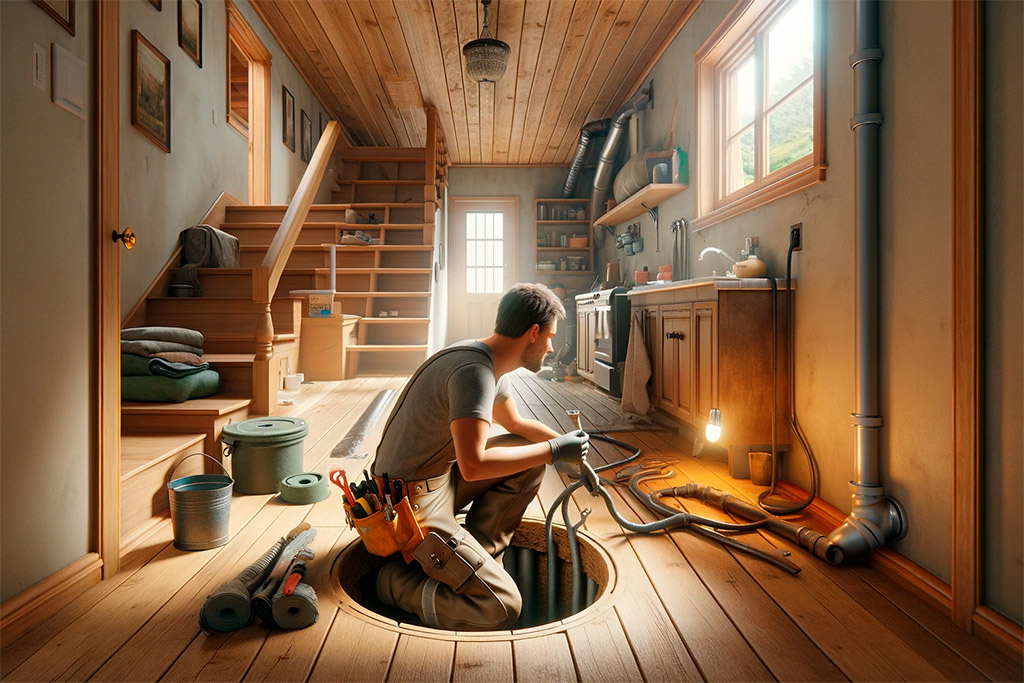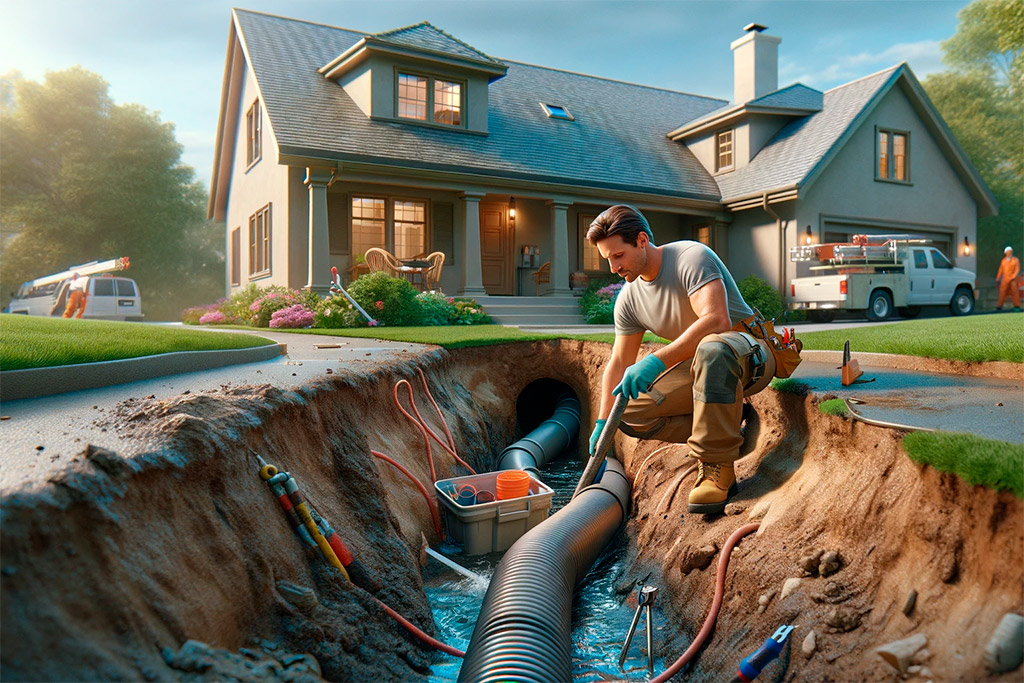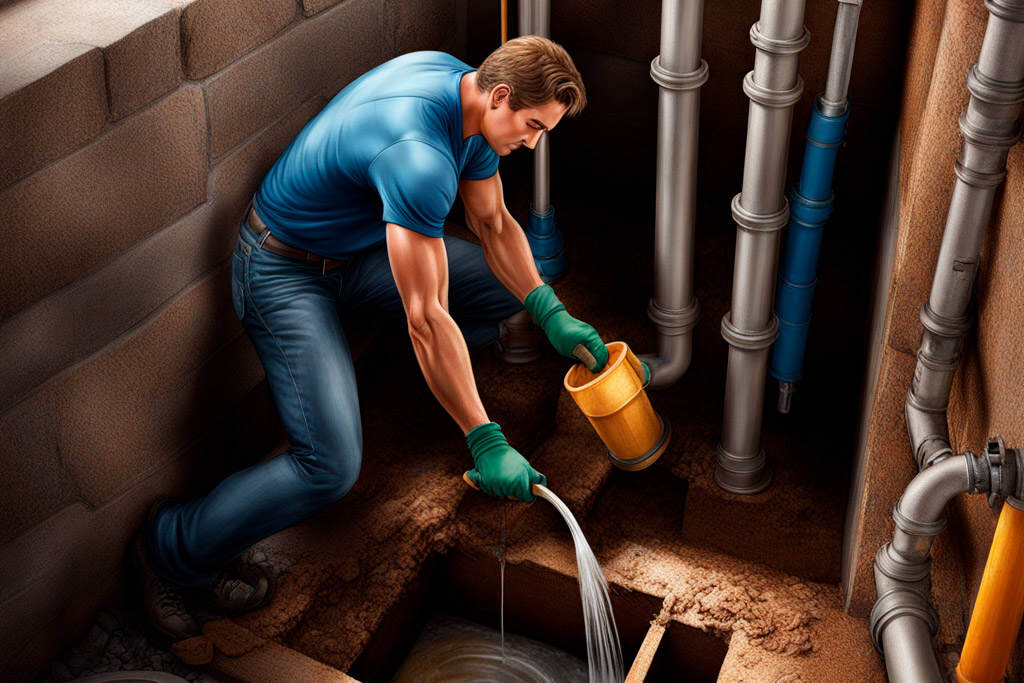Embarking on a sewer cleanout isn’t just a chore; it’s an essential part of home maintenance that guards against future plumbing disasters. For those of you rolling up your sleeves, whether you’re managing your own home or handling repairs in a professional capacity, understanding the importance and nuances of sewer cleanout is critical. It’s about creating a reliable and efficient environment, ensuring your plumbing system doesn’t turn into an unforeseen nightmare.

Understanding Sewer Cleanouts
A sewer cleanout serves as a vital access point to your property’s sewer line, allowing for clearing blockages and conducting routine inspections. It’s an integral part of your property’s plumbing system, akin to a health check-up path for your home’s waste disposal system. There are primarily two types:
- Main Line Cleanouts: These are your primary access points to the sewer line, linking your property to the communal sewer system or septic tank. They’re the main artery in your plumbing, handling the bulk of waste transit.
- Branch Cleanouts: These act as access points to the secondary pipes, similar to tributaries feeding into a larger river, managing the flow from various parts of your home to the main line.
Understanding these types helps in pinpointing problems and taking swift, accurate action when needed.
Identifying Your Sewer Cleanout
Locating your sewer cleanout is the first step in this journey. Here’s a practical approach to finding it:
- Outdoor Search: Begin outside, usually in the front yard. Look for a small, capped pipe, about 3 to 4 inches in diameter, peeking above ground. It’s often located near the bathroom but can vary depending on your home’s layout.
- Indoor Hunt: If it’s not outside, head to the basement or crawlspace. Look for a similar pipe with a cap, penetrating the wall.
- Visual Indicators: Cleanout caps are typically white or black and protrude from the ground or wall. They’re modest in appearance but crucial in function.
Homes, especially older ones, may have less obvious cleanout locations. If you’re struggling to find it, consulting a plumbing blueprint of your home can provide clarity. In my experience, cleanouts can be tucked away in the most unexpected places, so a thorough search is key.
By understanding and locating your sewer cleanout, you’re taking a significant step in proactive plumbing maintenance. Knowing where and how to access these points can save you time and trouble, especially when quick action is needed. In the next sections, we’ll delve into how to utilize these cleanouts for routine upkeep and in emergency situations. Remember, the goal is always proactive prevention, keeping your system running smoothly to avoid any unpleasant surprises.

The Importance of Regular Maintenance
In my extensive journey through the world of construction and renovation, I’ve come to understand the critical nature of regular maintenance for sewer lines. This isn’t just about keeping the system running; it’s about safeguarding your home from the ground up. Much like the foundation of a house, the plumbing system, especially the sewer lines, forms an integral part of a home’s overall health.
Let’s be clear: Neglecting the maintenance of your sewer lines is a gamble with high stakes. The repercussions extend beyond mere inconvenience; they can spiral into significant plumbing catastrophes, complete with costly repairs. And it’s not just about the money; a backed-up sewer line can pose serious health risks, exposing your family to unsanitary conditions.
DIY Tips: How to Clean Out Your Sewer Line
Here’s a step-by-step guide to a basic sewer line cleanout, based on my personal experiences and the countless renovations I’ve overseen:
- Safety First: Equip yourself with protective gear – gloves, goggles, and a mask are non-negotiables.
- Find Your Cleanout Point: Usually, it’s a capped pipe, about 4 inches in diameter, sticking out of the ground or located in the basement.
- Cap Removal: This might require some elbow grease. Use a wrench, but proceed with caution to avoid pressure build-up surprises.
- Initial Inspection: Use a flashlight to peer into the pipe. If you see an obstruction, it’s time to roll up your sleeves.
- Deploy the Drain Snake: This tool is indispensable for dislodging blockages. Feed it into the pipe, twist, and push to break up the clog.
- Flush the Line: Post-snake, run a garden hose down the pipe to ensure the blockage is completely cleared.
- Secure the Cap: Replace the cap firmly to prevent any unwelcome visitors or spills.
This approach is effective for routine cleanouts and minor clogs. However, not all blockages are equal.
When to Call a Professional
Sometimes, the situation calls for professional expertise. Here’s when you should step back and let the experts take over:
- Stubborn Clogs: If your efforts seem futile and the clog remains, professional equipment and expertise are necessary.
- Visible Pipe Damage: Cracks or leaks in the pipes are red flags. These issues require professional attention to prevent worsening.
- No Progress: If the situation doesn’t improve despite your best efforts, it’s time to call in a professional.
Choosing the right plumber is crucial. Opt for a licensed and insured professional with a solid reputation. Recommendations from fellow homeowners or colleagues can be invaluable here. A reliable plumber is an asset, particularly when you’re up against complex plumbing challenges.

Preventative Measures and Best Practices
Through my extensive experience in renovation, I’ve learned that consistent maintenance is key to a healthy sewer system. Here’s how you can keep those pipes in top shape:
- Routine Cleanings: Regularly flush your sewer lines with water to prevent build-up. This simple action can help maintain flow and prevent blockages.
- Watch What You Flush: One of the cardinal rules in plumbing is to be cautious about what goes down your drains. Avoid flushing anything other than waste and toilet paper. Items like cooking grease, non-biodegradable wipes, and other foreign objects are notorious for causing blockages.
- Consider Tree Placement: When landscaping, consider the location of your sewer lines. Tree roots are attracted to the moisture in sewer pipes and can cause significant damage. Planting trees at a safe distance can prevent root intrusion.
Troubleshooting Common Issues
No matter how well you maintain your system, problems can arise. Here’s how to address some common issues:
- Slow Drains: This often indicates a buildup. A plunger or a hand-cranked drain snake can often solve the problem. If these methods don’t work, it might be a sign of a deeper issue.
- Foul Odors: These can emerge from a dry trap, which is designed to block sewer gases from entering the home. Pouring water down infrequently used drains can reseal the trap.
- Sewage Backup: This is a serious issue. If sewage is backing up into your home, cease using water immediately and call a professional. This is typically indicative of a major blockage or a problem with the main line.
FAQ Section
Ideally, clean your sewer line every 18 to 22 months. However, this can vary based on factors like the age of your pipes, tree proximity, and usage patterns. Older systems or those near large trees may require more frequent cleanings.
Yes, you can. The cleanout is typically a capped pipe either sticking out of the ground or located in the basement. Wear appropriate protective gear as the contents can be hazardous. If you’re unsure about the process, it’s best to consult a professional.
Key indicators include multiple slow drains, unpleasant odors, gurgling noises from toilets, and water backing up when flushing. These symptoms suggest a blockage that needs immediate attention.
While chemical cleaners can offer a temporary solution, they often do more harm than good in the long run. These chemicals can corrode older pipes and are not environmentally friendly. Mechanical methods, such as using a drain snake, are usually safer and more effective.
Tree roots can intrude into sewer lines through even tiny cracks in search of water, leading to blockages and potential pipe damage. If roots are causing issues, a professional equipped with a rooter machine and possibly a camera can best assess and resolve the situation.
